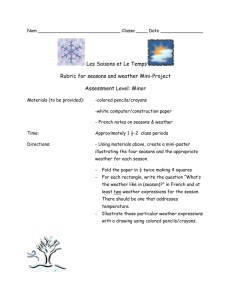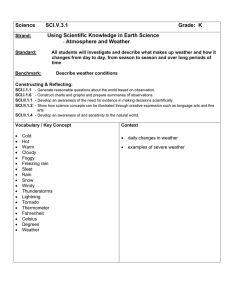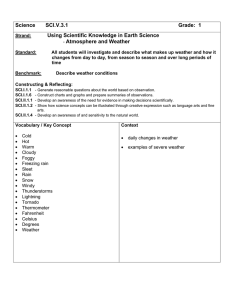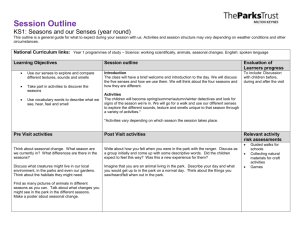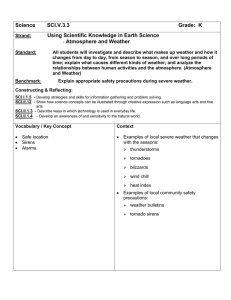Science SCI.V.3.2 Grade: K
advertisement
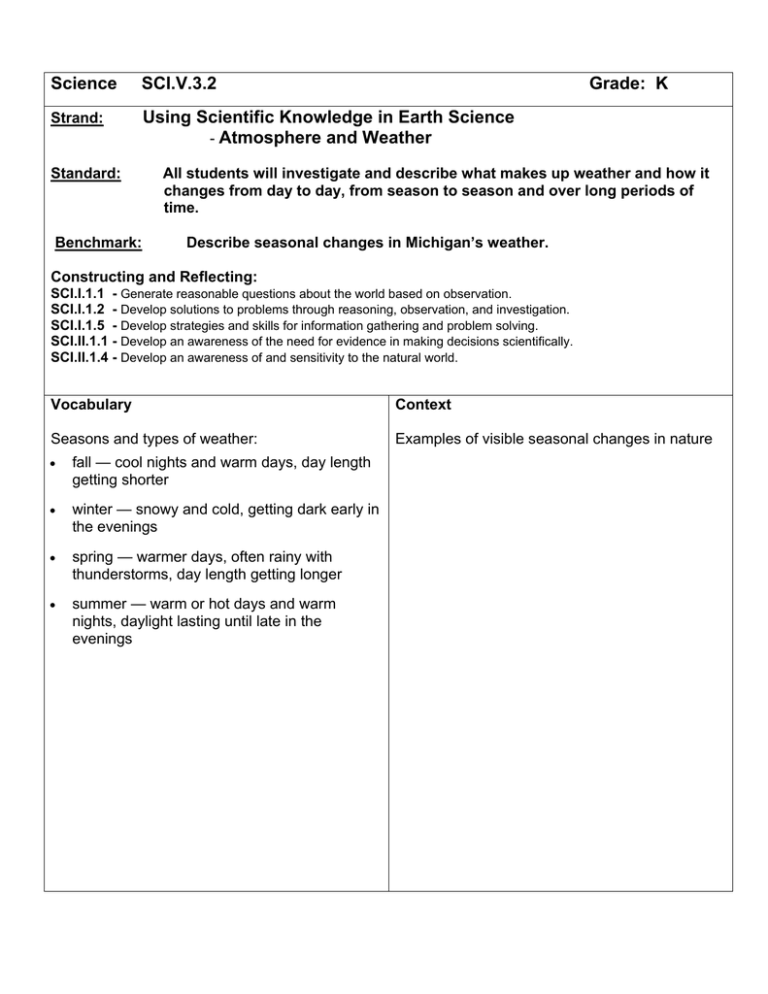
Science SCI.V.3.2 Strand: Using Scientific Knowledge in Earth Science - Atmosphere and Weather Standard: Benchmark: Grade: K All students will investigate and describe what makes up weather and how it changes from day to day, from season to season and over long periods of time. Describe seasonal changes in Michigan’s weather. Constructing and Reflecting: SCI.I.1.1 - Generate reasonable questions about the world based on observation. SCI.I.1.2 - Develop solutions to problems through reasoning, observation, and investigation. SCI.I.1.5 - Develop strategies and skills for information gathering and problem solving. SCI.II.1.1 - Develop an awareness of the need for evidence in making decisions scientifically. SCI.II.1.4 - Develop an awareness of and sensitivity to the natural world. Vocabulary Context Seasons and types of weather: Examples of visible seasonal changes in nature • fall — cool nights and warm days, day length getting shorter • winter — snowy and cold, getting dark early in the evenings • spring — warmer days, often rainy with thunderstorms, day length getting longer • summer — warm or hot days and warm nights, daylight lasting until late in the evenings Knowledge and Skills Michigan’s weather changes with the seasons. Resources Season Books from personal and school libraries Changes in weather will include: • Temperature • Precipitation (rain, snow) • Number of hours of sunlight Students will • • Compare and contrast seasonal changes in weather (fall, winter, spring, summer) Describe the effects on seasonal changes on: • Vegetation • Human activities Instruction Benchmark Question: What are the relationships between human activities and the atmosphere? Focus Question: How do the temperature and precipitation for each season affect what we wear? Whole Group Activity: Make a data chart labeled “SEASONS.” • Divide chart into 4 sections • Lead class discussion to name the seasons • Add pictures/words under each season to determine what happens each seasons: 1. What activities can we do during each season? 2. What grows during each season? 3. What do we wear during each season? Assessment Teacher Notes: Explain what causes different kinds of weather. The causes of different weather are not a priority in the elementary grades. The foundation for the causes of different kinds of weather is laid as young learners are able to identify the states of water (see the Hydrosphere). Students may believe that when water evaporates it disappears all together rather than just changing form. They may also think that it just changes location and is still a liquid. Late elementary students may understand that evaporated water is still in the air. Ideas such as air pressure and temperature changes with altitude become important in explaining the causes of different kinds of weather. Different forms of precipitation, relative humidity, dew point, and fog require this type of knowledge. Some students may think that water vapor and steam are held or soaked up by the air. They may not understand that steam, like air, is a gas and mixes with the other gases in the air and that water vapor is a liquid held in the air. As temperature increases more water vapor enters the gas phase. Students also envision that humid air is "heavier" than dry air. In fact, humid air is actually less dense than dry air of the same temperature. At the high school level, students will describe patterns of air movement in the atmosphere and how these patterns affect weather conditions. Pressure systems are particularly difficult to understand because air moves from high to low pressure.



